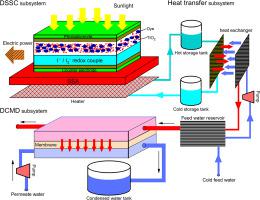当前位置:
X-MOL 学术
›
Desalination
›
论文详情
Our official English website, www.x-mol.net, welcomes your feedback! (Note: you will need to create a separate account there.)
Hybridizing photovoltaic cell with direct contact membrane distillation for electricity and freshwater cogeneration: Concept and performance evaluation
Desalination ( IF 9.9 ) Pub Date : 2020-12-01 , DOI: 10.1016/j.desal.2020.114701 Qin Zhao , Houcheng Zhang , Ziyang Hu
Desalination ( IF 9.9 ) Pub Date : 2020-12-01 , DOI: 10.1016/j.desal.2020.114701 Qin Zhao , Houcheng Zhang , Ziyang Hu

|
Abstract Electricity and freshwater are essential for daily routines, and the cogeneration of electricity and freshwater using solar energy is charming in islands and coastal areas. In this work, a novel hybrid system model mainly comprised of a dye-sensitized solar cell (DSSC) and a direct contact membrane distillation (DCMD) is put forward with the aim to harvest the long wavelength light transmitted through the DSSC for freshwater production. Considering various irreversible losses within the system, performance parameters of DSSC, DCMD and hybrid system are mathematically described, from which the hybrid system performance limits are discussed. Numerical calculations show that maximum efficiency and maximum power output density of hybrid system are, respectively, up to 45.35% and 453.52 W m−2, which are, respectively, 814.31% and 482.78% larger than that of stand-alone DSSC. Exhaustive sensitivity analyses are conducted to investigate how the proposed system performance is influenced by some operating conditions and designing parameters. It is found that feed water temperature, flow velocity of feed water and flow velocity of permeate water positively improve the performance of hybrid system, but permeate water temperature and Schottky barrier adversely affect the performance of hybrid system. The performance of hybrid system is further discussed under optimization conditions.
中文翻译:

用于电力和淡水热电联产的带有直接接触膜蒸馏的混合光伏电池:概念和性能评估
摘要 电力和淡水是日常生活的必需品,利用太阳能进行电力和淡水联产在岛屿和沿海地区具有吸引力。在这项工作中,提出了一种主要由染料敏化太阳能电池(DSSC)和直接接触膜蒸馏(DCMD)组成的新型混合系统模型,旨在收集通过 DSSC 传输的长波长光用于淡水生产。考虑到系统内部的各种不可逆损耗,对DSSC、DCMD和混合系统的性能参数进行了数学描述,从中讨论了混合系统的性能极限。数值计算表明,混合动力系统的最大效率和最大功率输出密度分别高达45.35%和453.52 W m-2,分别为814.31%和482。比独立的 DSSC 大 78%。进行详尽的敏感性分析以研究所提议的系统性能如何受某些操作条件和设计参数的影响。研究发现,给水温度、给水流速和产水流速对混合系统的性能有积极的提高,但产水温度和肖特基势垒对混合系统的性能有不利影响。在优化条件下进一步讨论混合系统的性能。进水流速和产水流速对混合系统性能有积极的提高,但产水温度和肖特基势垒对混合系统性能有不利影响。在优化条件下进一步讨论混合系统的性能。进水流速和产水流速对混合系统性能有积极的提高,但产水温度和肖特基势垒对混合系统性能有不利影响。在优化条件下进一步讨论混合系统的性能。
更新日期:2020-12-01
中文翻译:

用于电力和淡水热电联产的带有直接接触膜蒸馏的混合光伏电池:概念和性能评估
摘要 电力和淡水是日常生活的必需品,利用太阳能进行电力和淡水联产在岛屿和沿海地区具有吸引力。在这项工作中,提出了一种主要由染料敏化太阳能电池(DSSC)和直接接触膜蒸馏(DCMD)组成的新型混合系统模型,旨在收集通过 DSSC 传输的长波长光用于淡水生产。考虑到系统内部的各种不可逆损耗,对DSSC、DCMD和混合系统的性能参数进行了数学描述,从中讨论了混合系统的性能极限。数值计算表明,混合动力系统的最大效率和最大功率输出密度分别高达45.35%和453.52 W m-2,分别为814.31%和482。比独立的 DSSC 大 78%。进行详尽的敏感性分析以研究所提议的系统性能如何受某些操作条件和设计参数的影响。研究发现,给水温度、给水流速和产水流速对混合系统的性能有积极的提高,但产水温度和肖特基势垒对混合系统的性能有不利影响。在优化条件下进一步讨论混合系统的性能。进水流速和产水流速对混合系统性能有积极的提高,但产水温度和肖特基势垒对混合系统性能有不利影响。在优化条件下进一步讨论混合系统的性能。进水流速和产水流速对混合系统性能有积极的提高,但产水温度和肖特基势垒对混合系统性能有不利影响。在优化条件下进一步讨论混合系统的性能。



























 京公网安备 11010802027423号
京公网安备 11010802027423号